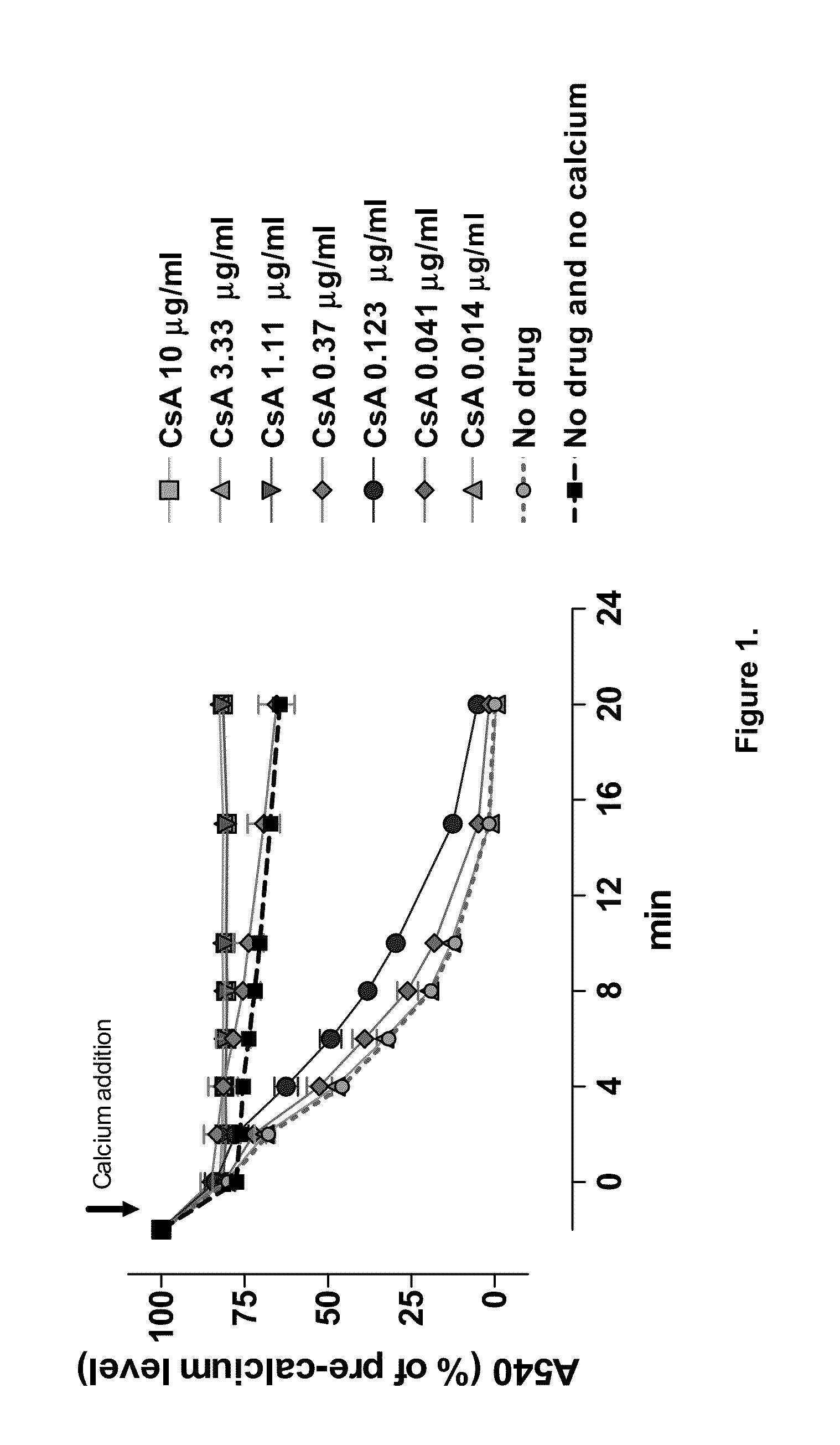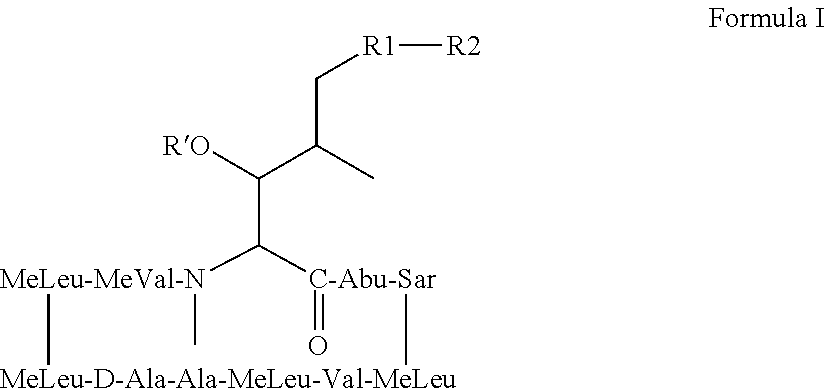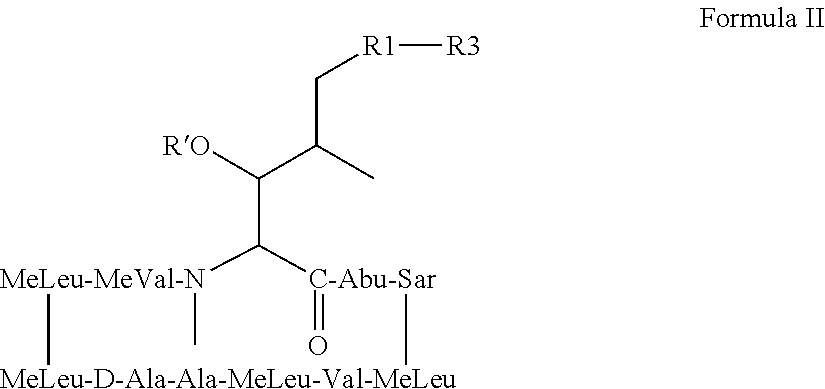Nonimmunosuppressive cyclosporine analogue molecules
a technology of cyclosporine and analogue molecules, applied in the field of new drugs, can solve the problems of cell death or apoptosis, hcv virus replication is significantly impeded by the lack of a suitable laboratory hcv model, and all hcv infected individuals are at risk of serious life-threatening liver diseases, etc., to achieve the effect of increasing the immunosuppressive effect of csa, reducing the utility, and little or reducing the immunosuppressive effect o
- Summary
- Abstract
- Description
- Claims
- Application Information
AI Technical Summary
Benefits of technology
Problems solved by technology
Method used
Image
Examples
example 1
Synthesis of 404-15
[0218]
[0219]As an illustrative example, triphenylphosphine (13 mmol) is dissolved in 50 mL toluene and chloroacetone (10 mmol) is added to give a clear solution. The reaction is stirred under reflux over night. A colorless solid is filtered off, washed with toluene and hexane and dried in vacuum.
[0220]Using Reaction 1, the following compounds are further examples of the compounds that may be synthesized.
CompoundReactant (R10-X)Conditions404-08 benzyl bromide4 hours at reflux404-09 methyl iodideRT over night404-12 4-nitrobenzyl bromide6 hours at reflux404-15 chloracetonereflux over night404-64 4-fluorobenzyl bromidereflux over night404-77 methyl 3- bromomethylbenzoate6 hours at reflux404-87 3-nitrobenzyl bromide6 hours at reflux404-161 1-bromo-2-butanoneRT over night404-170 4-bromobutyronitrilereflux over night
[0221]Alternatively, suitable phosphonium salts may be synthesized through Reaction 2 as illustrated below:
Reaction 2
[0222]
[0223]Where X is a halide...
example 2
Synthesis of 404-51
[0224]
[0225]As an illustrative example, triphenylphosphine (11 mmol) is dissolved in 10 mL DMF and 4-bromobutyric acid (10 mmol) is added. The reaction is stirred for 7 hours at 110° C. and is then allowed to cool over night. Fifty mL toluene is added and a crystalline, colorless solid is collected by filtration. The product is washed with toluene and hexane and dried in vacuum over night.
[0226]If crystallization does not set in after treatment with toluene, the product is extracted with 20 mL MeOH / H2O (1:1 mixture). The aqueous phase is washed with toluene and hexane and brought to dryness. The residue is stirred with 50 mL ethyl acetate (EtOAc) at reflux temperature for 20-30 min. If a crystalline solid is obtained, the product is collected by filtration, washed with EtOAc and hexane and dried. In case the product is obtained as an oil or gum, the EtOAc is decanted and the remaining product is dried in vacuum.
[0227]Using Reaction 2, the following compounds are f...
example 3
Synthesis of Compound 404-20 Using a Phosphonium Salt Compound Through a Wittig Reaction
[0232]
[0233]As an illustrative example, an oven dried 250 mL flask is charged under argon atmosphere with triphenylbutylphosphonium bromide (6.0 mmol) and 40 mL anhydrous tetrahydrofuran (THF). The suspension is cooled to 0° C. and potassium tert-butoxide (6.0 mmol) is added to obtain an orange color. The reaction is stirred at ambient temperature for 1-2 hours, followed by addition of CsA-aldehyde (2.0 mmol, dissolved in 20 mL anhydrous THF). Stirring is continued for 3 hours at room temperature. The reaction is quenched with 10 mL sat. NH4Cl and 20 mL ice-water. The layers are separated and the aqueous phase is extracted with EtOAc. The organic layers are combined, washed with brine and dried over Na2SO4. The solvent is removed and the crude product is purified over silica gel (hexane / acetone 3:1).
[0234]Using Reaction 3, the following compounds are further examples of the compounds that may be ...
PUM
| Property | Measurement | Unit |
|---|---|---|
| Temperature | aaaaa | aaaaa |
| Temperature | aaaaa | aaaaa |
| Temperature | aaaaa | aaaaa |
Abstract
Description
Claims
Application Information
 Login to View More
Login to View More - R&D
- Intellectual Property
- Life Sciences
- Materials
- Tech Scout
- Unparalleled Data Quality
- Higher Quality Content
- 60% Fewer Hallucinations
Browse by: Latest US Patents, China's latest patents, Technical Efficacy Thesaurus, Application Domain, Technology Topic, Popular Technical Reports.
© 2025 PatSnap. All rights reserved.Legal|Privacy policy|Modern Slavery Act Transparency Statement|Sitemap|About US| Contact US: help@patsnap.com



